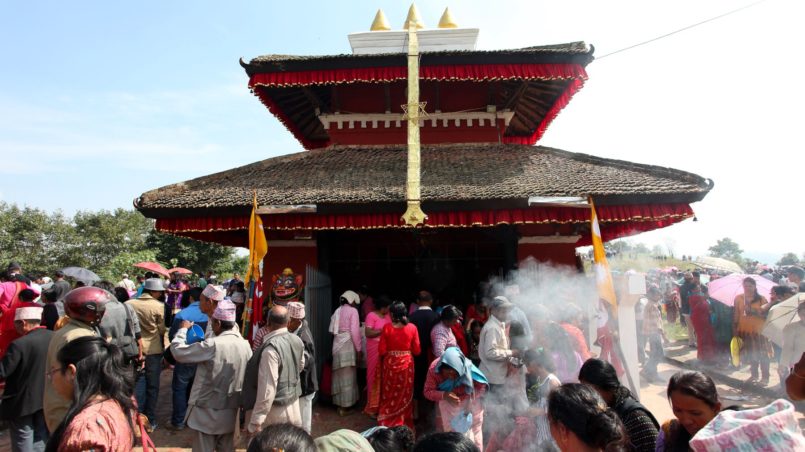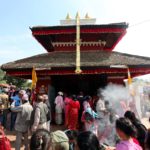The Most Barbaric Festival of Nepal

Last time, I took you to the Bara district of Nepal, where the world’s largest animal slaughter takes place in a very cruel and violent manner.
Again, this time I am taking you to another place in Nepal where people celebrate a festival called “Deu-Pokhari” in such way that, if you know about the way of celebrating this festival, your blood will boil at its highest level and your veins along with body parts may almost burst in anger. Yes, you heard it right. I am talking about the most barbaric festival that is celebrated in Khokana, a village in the Lalitpur district of Nepal.
Khokana, a tiny traditional Newari village, is believed to be the oldest village in Nepal situated in the Karyabinayak Municipality of the Lalitpur district, which is 8 kilometers south of the capital of Nepal, Kathmandu. Khokana is very famous because it has been producing rich mustard oil since ancient times. It is also nominated to be listed as a UNESCO World Heritage, representing a vernacular village. In addition, it is also the village which was first lit by electricity in Nepal in 1911. However, the saddest thing about Khokana is that, despite being the first place in Nepal with electricity, the people of Khokana still live in darkness as their minds are clouded by the superstition that lies within their tradition in the name of God and religion.
Deupokhari is one such festival. In Nepali, “Deu” means to give and “Pokhari” means pond. So, Deupokhari in Nepali refers to give something to the pond. Deupokhari is a 900-year old traditional festival which is particularly celebrated by the indigenous Newari people of Khokana. In the course of this festival, a live baby goat is ripped apart using teeth and bare hands and strangled by nine young men until it dies. People hold three major beliefs regarding the background to this festival:
- First, at around the 12th century, the children of Deupokhari started to die after they fell into a pond. As the number of dying children started to increase, people thought that a demon lived in the pond. So, to save the lives of children, locals started to throw a live female baby goat into the pond to pacify the pond-demon. Later, this system started as a tradition to appease the divine power within the pond. Since then, this tradition has continued.
- Second, people believe that a goat is offered as a sacrifice to appease the nearby goddess Rudranayani whose temple is close to the pond.
- Third, during the Rana regime in Nepal, a local administrator of Khokana named “Dawarea” threw a live goat into the pond to express his happiness. Later, a group of local people jumped into the pond and retrieved the goat to please him.
These are the myths regarding the origin of the Deupokhari festival. Now let’s move towards main theme of the article i.e. how the most brutal, vicious and barbaric festival is celebrated in Khokana. The Deupokhari festival is celebrated every year in August after the day of “Gai Jatra”. The Khokana Festival Committee makes all the necessary preparation for the celebration of this festival. Since Khokana was a V.D.C. (Village Development Committee) in the past, it was divided into nine wards. Nine of the bravest men from each ward of Khokana are selected and they later compete with each other to kill a baby goat. The male who kills the baby goat the fastest and in the worst manner is declared the “hero” and winner.
After the traditional rituals are completed by the members of the Khokana Festival Committee, one of its members throws a 5/6-month-old female baby goat into the Deupokhari (pond). As soon as the baby goat is thrown into the pond, those nine young wild men jump into the pond at the speed of a rocket to snatch the helpless and defenseless baby goat. The baby goat is pulled from nine sides as if it were a toy. It is bitten, ripped, pulled apart and strangled by those nine men using their teeth and bare hands.
As soon as the goat dies, the male who killed it quickest is declared the winner and is regarded as a “hero” for one year. It is also believed that the male who kills the goat fastest will have a very happy and prosperous year. The winning male now has to lead the celebratory Shinkali dance which follows the blood-curdling satanic aftermath. During the celebration, people jubilantly sing, dance and bless each other.
This is how the savage of Khokana celebrate the most barbaric festival in Nepal. In this 21st century, can we believe that people are not aware of animal rights? I think obliviously they are. This festival seems to be celebrated merely to torture a helpless female baby goat. In my opinion, this festival should be banned as soon as possible. Although this festival has been met with strong outrage and condemned by animal rights’ associations, such as Animal Welfare Network Nepal (A.W.N.N.), Animal Rights Club Nepal, Animal Recovery Mission and internationally renowned organizations like PeTA, the Khokana Festival Committee still does not believe that the festival should be prohibited the festival.
PeTA along with A.W.N.N. has already spearheaded a petition campaign against this festival branding it “barbaric”. PeTA has described the festival as “uniquely savage and disgusting” and has said that, “Such a cruel and vicious act inflicted on an animal has no place in civilized society and should be immediately banned“. Being intelligent and aware human beings, how can we allow this type of festival to continue in our societies? Let’s be responsible citizens and start a campaign to ban this festival.
Credits
| Image | Title | Author | License |
|---|---|---|---|
 |
Cover-Khokana-The Most Barbaric Festival of Nepal | Dinesh 2016 | CC BY-SA 4.0 |

I agree that this festival should end with time but im really offended by the the wrong and over extended article this is. First of all the name you chose ‘deupokhari’ is wrong , its depukhu. De means village and pukhu means pond named only roughly after 90s earth quake as gajur of the rudrayeni temple fell on it, people started calling it central pond of the village.
About the tradition , (worst part ) killing of a goat ( its not a baby im sure) . She is let to drown till death. ( Feel sorry too) later only the participants go to fetch the goat. They dont bite or tear her to death. You jotted it wrong.
The stories may be true , but no one is hero or a winner as it is not a game , those who fetch the goat has responsibilty to show the traditional show in the village. ( This tradition still continued for this reason i guess).
Moreover people of khokana are not cruel or vicious. You will never find a village where 100s of goats are allowed to roam freely around the village. Yes people agree this tradition needs to come to end and it will someday.
I would like to request to do some more research on this tradition if you want to give so much details. Better not give the wrong ones.
Mr. Yugesh, regarding the name of the festival, the two words, De and Pukhu are original words. I agree with you, but you must not forget these are Newari words not Nepali. In Newari De means village and Pukhu means Pokhari (pond). I haven’t written the name of the festival, De-Pukhu, I have written, Deu-Pokhari, which both are Nepali words. The word De, after a long follow up of pronunciation from one generation to next generation, it became Deu and all common Nepalese people started to spell and understand the word as Deu and which in Nepali means to give. Hence the name of the festival in Nepali became “Deu-Pokhari”. Regarding the goat, so far i know, 5-6 months goat is thrown into the pond. When the average life span age of goat is 15-18 years, then why can’t we tell 5-6 months goat a baby goat. And lastly, you say the festival is not barbaric, the goat is not ripped, we have lots of pictures and images to show you as proof. Thank You..!!!